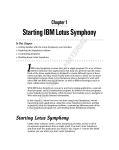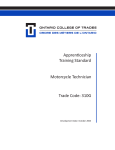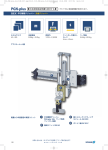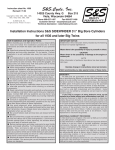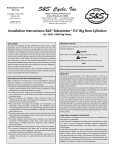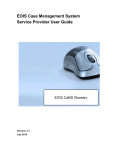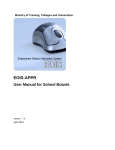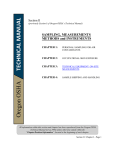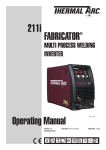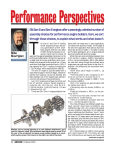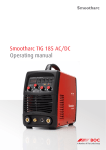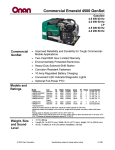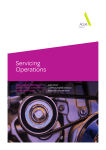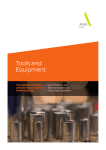Download Level 1 - Ontario College of Trades
Transcript
Apprenticeship Curriculum Standard Motorcycle Technician Level 1 Trade Code: 310G Date: 2007 Please Note: Apprenticeship Training and Curriculum Standards were developed by the Ministry of Training, Colleges and Universities (MTCU). As of April 8th, 2013, the Ontario College of Trades (College) has become responsible for the development and maintenance of these standards. The College is carrying over existing standards without any changes. However, because the Apprenticeship Training and Curriculum Standards documents were developed under either the Trades Qualification and Apprenticeship Act (TQAA) or the Apprenticeship and Certification Act, 1998 (ACA), the definitions contained in these documents may no longer be accurate and may not be reflective of the Ontario College of Trades and Apprenticeship Act, 2009 (OCTAA) as the new trades legislation in the province. The College will update these definitions in the future. Meanwhile, please refer to the College’s website (http://www.collegeoftrades.ca) for the most accurate and up-to-date information about the College. For information on OCTAA and its regulations, please visit: http://www.collegeoftrades.ca/about/legislation-and-regulations Ontario College of Trades © Motorcycle Technician – Level 1 TABLE OF CONTENTS Introduction .................................................................................................................... 2 Program Summary of Reportable Subjects .................................................................. 3 S0146 Engines ............................................................................................................ 4 1.1 - Engines .................................................................................................... 5 1.2 - Engine Lubrication systems ................................................................... 13 S0147 Power Trains ................................................................................................. 16 2.1 - Primary Drive Systems........................................................................... 17 2.2 - Clutches.................................................................................................. 20 2.3 - Manual Transmissions ........................................................................... 24 S0148 Braking Systems and Chassis ..................................................................... 27 3.1 - Braking Systems .................................................................................... 28 3.2 - Chassis................................................................................................... 33 S0149 Electrical/Electronic and Fuel Systems ...................................................... 38 4.1 - Electrical/Electronic System Fundamental............................................. 39 4.2 - Lead Acid Batteries ................................................................................ 43 4.3 - Applied Electrical Schematics ................................................................ 46 4.4 - Fuel Systems........................................................................................... 48 S0150 Work Practices............................................................................................... 53 5.1 - Workshop Practices and Procedures..................................................... 54 5.2 - Fastening & Sealing Techniques ........................................................... 58 5.3 - Welding.................................................................................................... 61 Ontario College of Trades © Motorcycle Technician – Level 1 Introduction This new curriculum standard for the Motorcycle Technician trade is designed from the learning outcomes, which were developed from the industry-approved training standard. The curriculum is organized into 2 levels of training, each including reportable subjects containing learning outcomes to reflect the units of the training standard. The hours charts indicate how the curriculum can be delivered in the current block release format and summarizes the hours of training for each reportable by level. Since the reportable subjects are all divisible by three they can be adapted to accommodate a more flexible training delivery other than block release. The reportable subjects are cross-referenced to the training standard for ease of comparison. Each reportable subject and learning outcome identifies a recommended number of training hours. This hour allotment is broken into hours for instruction in theory and practical application. The division of the curriculum into reportable subjects follows a natural progression of learning through the training program. This structure will allow training centres and apprentices’ flexibility in program delivery while still observing the importance of sequencing learning in a logical progression. The curriculum is framed by and includes specific references to terminal performance objectives in the Apprenticeship Training Standards. However, the curriculum identifies only the learning that takes place off the job, in a training environment. The in-school program focuses primarily on the theoretical knowledge required to master the performance objectives of the Training Standards. Employers are expected to extend the apprentice’s knowledge and skills through appropriate practical training on the work site. Regular evaluations of the apprentice’s knowledge and skills are conducted throughout training to assure that all apprentices have achieved the learning outcomes identified in the curriculum standard. The balance between theoretical and practical evaluation is identified for each unit of learning outcomes. Implementation date: September, 2007 2 Ontario College of Trades © Motorcycle Technician – Level 1 Program Summary of Reportable Subjects Hours Total Hours Theory Hours Practical Number Reportable Subjects S0146 Engines 62 45 17 S0147 Power Trains 36 22 14 S0148 Brakes and Chassis 40 20 20 S0149 Electrical/Electronic and Fuel Systems 62 40 22 S0150 Work Practices 40 24 16 Total 240 151 89 3 Ontario College of Trades © Motorcycle Technician – Level 1 Number: S0146 Title: Engines Duration: 62 Total Hours Theory: 45 hours Practical: 17 hours Prerequisites: None Co-requisites: Level 1 Reportable Subject S0147, S0148, S0149, S0150 Evaluation & Testing: - Assignments related to theory and appropriate application skills. Minimum of one mid-term test during the eight-week term. Final exam at end of term. Periodic quizzes. General Learning Outcome Upon successful completion of this reportable subject, the apprentice is able to service and repair engines in accordance with government safety regulations, manufacturer’s recommendations and specifications and approved industry standards. 4 Ontario College of Trades © Motorcycle Technician – Level 1 Number: 1.1 Title: Engines Duration: 58 Total Hours Prerequisites: None Co-requisites: Level 1 Reportable Subject S0147, S0148, S0149, S0150 Theory: 42 hours Practical: 16 hours Cross-Reference to Training Standards: 4133.0 to 4133.05; 4133.07 to 4133.17; 4134.0 to 4134.24; 4134.35 to 4134.38 GENERAL LEARNING OUTCOME Demonstrate a working knowledge of the definitions and applied fundamentals of 2 and 4 stroke cycle motorcycle internal combustion engines. LEARNING OUTCOMES Upon successful completion, the apprentice is able to: 1.1.1 Outline the history, purpose, function, type, styles and application of engines. motorcycle 1.1.2 Describe the basic principles of operation of motorcycle engines. 1.1.3 Describe the construction and principles of operation of 4 stroke cycle engines. 1.1.4 Describe the construction and principles of operation of a 2 stroke cycle motorcycle engine. 1.1.5 Demonstrate a theoretical understanding of motorcycle 2 and 4 stroke cycle top end repair practices. 1.1.6 Perform assigned 2 and 4 Stroke Cycle top end repair practices. 1.1.7 Perform assigned operations on motorcycle 2 and 4-stroke cycletop end assemblies. 1.1.8 Describe manufacturer’s test and maintenance procedures for 2 and 4 stroke cycle motorcycle top end disassembly / reassembly procedures. 5 Ontario College of Trades © Motorcycle Technician – Level 1 Learning Content 1.1.1 Explain the history, purpose, function, type, styles and application of motorcycle engines. [4/0] fundamentals: - bore - stroke - engine displacement - brake power - compression ratio - pressure-efficiency ratios - thermal efficiency - mechanical efficiency - gas expansion - mechanical advantage - inertia - engine breathing - gas inertia - balance shifts 1.1.2 Describe the basic principles of operation of motorcycle engines. [4/0] power transfer - piston - connecting rod - crankshaft - primary drive fixed engine components - cylinder head - squish band - cylinder - crank case - engine covers induction and exhaust principles - engine breathing 1.1.3 Describe the construction and principles of operation of 4 stroke cycle engines. [6/2] 4-stroke cycle sequencing - intake - power 6 Ontario College of Trades © Motorcycle Technician – Level 1 - valve timing - compression - exhaust valve arrangements - side valve - overhead valve - pushrod - overhead cam valve configurations - single - multiple valve operating mechanisms - camshaft - rocker arms/lifters/pushrods - camshaft drive - roller chain/sprockets - inverted tooth chain/sprockets - toothed belt/pulley - gear - valve lash factors - hydraulic - adjuster screw/locknut - eccentric - shim - decompression mechanisms combustion chambers - hemispherical - multispherical - bath tub - wedge pistons - forged - cast - silicon content - piston section - coatings - crown design - cam ground - taper - pin offset 7 Ontario College of Trades © Motorcycle Technician – Level 1 1.1.3 - pin support area - cir-clip groove ring design - compression rings – types - oil control – types - sealing - scraper cylinder wall materials - cast iron - sleeve - aluminum - coatings crankshafts - one piece/assembled 1.1.4 Describe the construction and principles of operation of a 2 stroke cycle motorcycle engine. [6/2] 2 stroke cycle event sequencing - intake - primary compression - transfer - secondary compression - combustion/power - exhaust induction system - piston port - inspection - measurement - out of service - timing – out of service reed - cylinder - crankcase - materials rotary - timing symmetrical/asymmetrical - sequencing crankshaft - assembled decompression mechanisms 8 Ontario College of Trades © Motorcycle Technician – Level 1 crankcase sealing - oil seals - gaskets - crankcases pistons - dome design - cam ground - taper - pin offset - pin bosses - cir-clip groove - ring locating pins - skirt - coatings ring types - rectangular - stepped - keystone - L ring ring materials - cast iron - steel - coatings - chrome - molybdenum - chromium exhaust - port - variable exhaust port timing - exhaust system controls 1.1.5 Demonstrate a theoretical understanding of motorcycle 2 and 4 stroke cycle top end repair practices. [16/0] cylinder heads and related components - head gasket surface distortion - measuring - resurfacing analyze causes of cam wear - inspection - measurements - rockers - rocker shafts - camshaft bearing journal 9 Ontario College of Trades © Motorcycle Technician – Level 1 - camshaft adjusters - camshaft drive components - valve train components cylinder head reconditioning - valve guide replacement - valve guide sealing components - refinishing valve seat - carbon removal - spark plug thread reconditioning cylinder - clearance, taper and out of round measurement - inspect cylinder wall surface - cast iron liner - coated/plated cylinder bores - remove cylinder ridge - significance of cross-hatch pattern - hone types - ball - spring loaded - rigid - wet/dry cylinder sleeves - cylinder gasket surface distortion - re & re procedures - cleaning - resizing & resleeving - torque plates - chamber cylinder ports - power valve clearance piston assembly - cam ground - measuring and inspection of pistons - cleaning and re-installation of pistons - piston pin - bushings - bearings connecting rod - reconditioning practices - testing straightness - testing twisting - big end bearings - rod thrust washer - small end bushings - caged - uncaged - insert bearing 10 Ontario College of Trades © Motorcycle Technician – Level 1 1.1.6 Perform assigned 2 and 4 stroke cycle top end repair practices. [0/6] measure and inspect cylinder heads and related components - analyze causes of cam wear - check cylinder head gasket surface distortion - rocker - rocker shaft - camshaft bearing journal - camshaft drive components - checking cylinder head for warping inspection and replacement of - valve guides - valve guide sealing components recondition valve seats - carbon removal - cutting valve angles - setting valve seat width cylinder, piston rings - taper out of round and ID measurement - inspect cylinder wall surface - deglaze/resize cylinder - cast iron cylinder bore - coated/plated cylinder bores - ring locating pin - piston ring end gap - piston ring side clearance - inspection of wet / dry cylinder sleeves - piston diameter/clearance to cylinder 1.1.7 Perform assigned operations on motorcycle 2 and 4 stroke cycle top end assemblies. [2/6] compression/primary compression test combustion chamber leakdown test crankcase pressure test valve lash adjustment disassembly practices reassembly practices routine service procedures preventative maintenance noise diagnosis spark plug condition diagnosis 11 Ontario College of Trades © Motorcycle Technician – Level 1 1.1.8 Describe manufacturers' test and maintenance procedures for 2 and 4 stroke cycle motorcycle top end disassembly / reassembly procedures. [4/0] Applied tools and equipment - pressure gauges - compression gauges - vacuum gauges - leakdown tester - precision measuring - micrometer - Vernier caliper - telescopic gauges - dial bore gauge - plasti-gauge - manufacturers' special service tools - V-blocks - valve/valve seat serving & reconditioning equipment - surface plate - measuring to spec - service limits - preventative maintenance schedules - technical service bulletins - service manual interpretation Applied safety precautions - eye, hand, face and hearing protection - hoists and stands - solvents/sealers - lifting techniques 12 Ontario College of Trades © Motorcycle Technician – Level 1 Number: 1.2 Title: Engine Lubrication Systems Duration: 4 Total Hours Prerequisites: None Co-requisites: Level 1 Reportable Subject S0147, S0148, S0149, S0150 Theory: 3 hours Practical: 1 hours Cross-Reference to Training Standards: 4133.0; 4133.06; 4133.29; 4133.30; 4134.0; 4134.06; 4134.32; 4134.40 GENERAL LEARNING OUTCOMES Demonstrate a working knowledge of the definitions and applied fundamentals of motorcycle internal combustion engine lubrication systems. LEARNING OUTCOMES Upon successful completion, the apprentice is able to: 1.2.1 Define the introductory information and fundamentals of motorcycle engine lubrication systems. 1.2.2 Describe the construction and principles of operation of engine lubrication circuits. 1.2.3 Perform assigned preventative maintenance procedures. 13 Ontario College of Trades © Motorcycle Technician – Level 1 Learning Content 1.2.1 Define the introductory information and fundamentals of engine lubrication systems. [1/0] fundamentals - heat and friction - heat dissipation - viscosity 1.2.2 Describe the construction and principles of operation of engine lubrication circuits. [2/0] 4 stroke cycle lubrication circuits - high pressure - low pressure - wet sump - dry sump oil filtering systems - centrifugal - screen type - wire mesh - filtering media - full flow filters - bypass filters oil pumps - plunger - gear - trochoid rotor relief valves lubrication circuitry - oil jets - oil coolers - external hoses - internal passages 2 stroke cycle lubrication - performance effects of fuel/oil ratio - pre-mix - fuel/oil ratios - oil injection systems - adjustment procedures 14 Ontario College of Trades © Motorcycle Technician – Level 1 1.2.3 Perform assigned preventative maintenance procedures. [0/1] 4 Stroke Cycle - change oil and filter 2 Stroke Cycle - bleed oil injection system - inspect/adjust oil injection pump applied safety precautions - eye, face and hand protection - hoists and stands - solvents - environmentally safe disposal of used lubricants - hot lubricant hazards applied tools and equipment - pressure gauges - manufacturers’ special service tools 15 Ontario College of Trades © Motorcycle Technician – Level 1 Number: S0147 Title: Power Trains Duration: 36 Total Hours Theory: 22 hours Practical: 14 hours Prerequisites: None Co-requisites: Level 1 Reportable Subject S0146, S0148, S0149, S0150 Evaluation & Testing: - Assignments related to theory and appropriate application skills. Minimum of one mid-term test during the eight-week term. Final exam at end of term. Periodic quizzes. General Learning Outcome Upon successful completion of this reportable subject, the apprentice is able to remove, diagnose, repair and install variable ratio belt drive system and final drive units, in accordance with government safety regulations, manufacturer’s recommendations/ specifications and approved industry standards. 16 Ontario College of Trades © Motorcycle Technician – Level 1 Number: 2.1 Title: Primary Drive Systems Duration: 8 Total Hours Prerequisites: None Co-requisites: Level 1, Reportable Subject S046, S0148, S0149, S0150 Theory: 6 hours Practical: 2 hours Cross-Reference to Training Standards: 4139.0; 4139.01; 4139.04; 4139.05 GENERAL LEARNING OUTCOME Demonstrate a working knowledge of motorcycle primary drive systems. LEARNING OUTCOMES Upon successful completion, the apprentice is able to: 2.1.1 Outline the history, purpose, types, functions and applications of motorcycle primary drive systems. 2.1.2 Describe the construction and principles of operation of motorcycle primary drive systems. 2.1.3 Demonstrate a working knowledge of motorcycle primary drive systems. 2.1.4 Describe manufacturers' testing and maintenance procedures for motorcycle primary drive systems. 17 Ontario College of Trades © Motorcycle Technician – Level 1 Learning Content 2.1.1 Outline the history, purpose, types, functions and applications of motorcycle primary drive systems. [1/0] fundamentals - splines and keys - chains - gears - sprockets - gear ratios - adjusters - lubrication - primary shafts 2.1.2 Describe the construction and principles of operation of motorcycle primary drive systems. [4/0] chain type primary drive systems - roller multiple link chains/sprockets - inverted tooth chains/sprockets - compensating sprockets (dampers) - adjusters gear type primary drive systems - straight cut - straight cut offset - helical cut gears belt type primary drive systems - materials and design - adjusters 2.1.3 Demonstrate a working knowledge of motorcycle primary drive systems. [0/2] adjustments of chains and belts - manual - automatic - removal and replacement - primary drive systems - chain - gear - belt type - checking backlash 18 Ontario College of Trades © Motorcycle Technician – Level 1 inspect primary drive power flow inspect primary drive lubrication 2.1.4 Describe manufacturers' testing and maintenance procedures for motorcycle primary drive systems. [1/0] chain wear sprocket wear correct end play sprocket alignment belt wear and condition gear condition adjuster operation applied safety precautions - exposed rotating component hazards i.e. exposed primary drives - eye, face and hand protection - hoists and stands - solvents applied tools and equipment - belt tension gauge - precision measuring tools - manufacturers' special servicing tools - pullers - holding devices 19 Ontario College of Trades © Motorcycle Technician – Level 1 Number: 2.2 Title: Clutches Duration: 12 Total Hours Prerequisites: None Co-requisites: Level 1 Reportable Subject S0146, S0148, S0149, S0150 Theory: 8 hours Practical: 4 hours Cross-Reference to Training Standards: 4139.00; 4139.01; 4139.02; 4139.03; 4139.06; 4139.07 GENERAL LEARNING OUTCOMES Demonstrate a working knowledge of motorcycle clutch assemblies. LEARNING OUTCOMES Upon successful completion, the apprentice is able to: 2.2.1 Describe the history, purpose, function types and application of motorcycle clutch assemblies. 2.2.2 Describe the construction and principles of operation of motorcycle clutch assemblies. 2.2.3 Dismantle, inspect, test and reassemble motorcycle clutch assemblies. 2.2.4 Describe manufacturers' testing and maintenance procedures for motorcycle clutch assemblies. 20 Ontario College of Trades © Motorcycle Technician – Level 1 Learning Content 2.2.1 Describe the history, purpose, function, types and application of motorcycle clutch assemblies. [2/0] fundamentals - friction - coefficient of friction - leverage - multi-plate type - centrifugal shoe type - centrifugal ramp type 2.2.2 Describe the construction and principles of operation of motorcycle clutch assemblies. [5/0] multi-plate type - wet - dry - clutch hub - clutch housing - pressure plate - clutch springs - coil - diaphragm - judder spring - wave washers - clutch drive plates - design and materials - clutch driven plates - design and materials - back torque limiters centrifugal shoe type centrifugal ramp type clutch actuating mechanisms - shift lever controlled actuation - centrifugal mechanism - screw mechanism - ball and ramp mechanism - hydraulic actuation - rack and pinion 21 Ontario College of Trades © Motorcycle Technician – Level 1 2.2.3 Demonstrate the dismantling, inspection, adjustment, testing and reassembly procedures of motorcycle clutch assemblies. [0/4] multi-plate type - shimming - measure drive plate thickness and claw width - custom pack dimension - measure driven plates for distortion - measure free length and tension of coil spring - measure free height of diaphragm spring - inspect condition of clutch housing - inspect condition of clutch hub - inspect condition of wave washer - inspect clutch pressure plate for damage, wear, distortion shoe type centrifugal clutch - inspect condition and measure shoe lining thickness - measure and inspect drum - inspect springs ramp type centrifugal clutch - inspect condition of rollers - inspect condition of ramps - measure free length and tension of springs - measure and inspect plates clutch fastening devices clutch actuating mechanisms - shift lever controlled actuation - centrifugal mechanism - screw mechanism - ball and ramp mechanism - hydraulic actuation - rack and pinion - back torque limiter adjustment - on engine - off engine - damage/wear assessment diagnose clutch problems - slippage - drag - chatter - improper release - incorrect release RPM (centrifugal type) - improper release (action?) of back torque limiter 22 Ontario College of Trades © Motorcycle Technician – Level 1 2.2.4 Describe manufacturers' testing and maintenance procedures for motorcycle clutch assemblies. [1/0] preventative maintenance adjustment schedule - safety precautions - asbestos hazards - friction media dust hazards - eye, hand and breathing protection - compressed spring precautions - applied tools and equipment - measuring tools - manufacturers' special service tools - pullers and holding devices 23 Ontario College of Trades © Motorcycle Technician – Level 1 Number: 2.3 Title: Manual Transmissions Duration: 16 Total Hours Prerequisites: None Co-requisites: Level 1 Reportable Subject S0146, S0148, S0149, S0150 Theory: 8 hours Practical: 8 hours Cross-Reference to Training Standards: 4139.0; 4139.01; 4139.08 to 4139.17 GENERAL LEARNING OUTCOMES Demonstrate a working knowledge of motorcycle manual transmissions and overhaul practice and procedure. LEARNING OUTCOMES Upon successful completion, the apprentice is able to: 2.3.1 Describe the history, purpose, function, types and application of motorcycle manual transmissions and the overhaul procedure. 2.3.2 Describe the construction and principles of operation of motorcycle manual transmissions. 2.3.3 Demonstrate the dismantling, inspection, testing and reassembly of motorcycle manual transmissions. 24 Ontario College of Trades © Motorcycle Technician – Level 1 Learning Content 2.3.1 Describe the history, purpose, function, types and application of motorcycle manual transmissions and overhaul procedure. [1/0] fundamentals - leverage - ratios power flow characteristics of gear box 2.3.2 Describe the construction and principles of operation of motorcycle manual transmissions. [7/0] gear theory - materials - bushings - bearings - ratios - torque - power flow shift drums - materials - designs - operation shift mechanism - design - operation lubrication principles - pressure feed - splash mechanical kick starter mechanisms - ratchet type - screw type - pawl lifter type electric starter mechanisms - sprag type - spring/roller type - bendix type 25 Ontario College of Trades © Motorcycle Technician – Level 1 2.3.3 Demonstrate the dismantling, inspection, testing and reassembly of motorcycle manual transmissions. [0/8] gear box components - shafts - fixed gears - bushings and bearings - free wheeling gears - fasteners and clips - splined sliding gears - linkages - shift forks - shift drum/cam plate inspect shaft endplay and gear alignment inspect transmission lubrication circuit - pressure feed - splash mechanical kick start components - ratchet type - screw type - pawl lifter type - disassembly, inspection and reassembly procedures electric starter mechanisms - sprag type - spring/roller type - bendix type - disassembly, inspection and reassembly procedures transmission overhaul techniques gear to shaft fitting techniques - pressing - oven - gear heating - interference fit failure analysis applied safety precautions - exposed rotating component precautions - eye and hand protection - hoists and stands - solvents applied tools and equipment - precision measuring tools - manufacturer’s special service tools - machinists’ paste - pullers 26 Ontario College of Trades © Motorcycle Technician – Level 1 Number: S0148 Title: Braking and Chassis Duration: 40 Total Hours Theory: 20 hours Practical: 20 hours Prerequisites: None Co-requisites: Level 1 Reportable Subject S0146, S0147, S0149, S0150 Evaluation & Testing: - Assignments related to theory and appropriate application skills. Minimum of one mid-term test during the eight-week term. Final exam at end of term. Periodic quizzes. General Learning Outcome Upon successful completion of this reportable subject, the apprentice is able to service and repair braking systems & chassis in accordance with government safety regulations, manufacturer’s recommendations and specifications and approved industry standards. 27 Ontario College of Trades © Motorcycle Technician – Level 1 Number: 3.1 Title: Braking Systems Duration: 20 Total Hours Prerequisites: None Co-requisites: Level 1 Reportable Subject S0146, S0147, S0149, S0150 Theory: 9 hours Practical: 11 hours Cross-Reference to Training Standards: 4143.0 to 4143.10; 4144.0 to 4144.05; 4144.06; 4144.09; 4144.10 GENERAL LEARNING OUTCOMES Demonstrate a working knowledge of motorcycle brake systems. LEARNING OUTCOMES Upon successful completion, the apprentice is able to: 3.1.1 Describe the history, purpose, function, types and application of motorcycle braking systems. 3.1.2 Describe the construction and principles of operation of motorcycle braking systems. 3.1.3 Demonstrate the dismantling, inspection, testing and reassembly of motorcycle braking systems. 3.1.4 Perform the disassembly, cleaning, inspection, testing and reassembly of hydraulic braking systems. 3.1.5 Perform the disassembly, inspection, testing and reassembly of brake friction assembly systems. 28 Ontario College of Trades © Motorcycle Technician – Level 1 Learning Content 3.1.1 Describe the history, purpose, function, types and application of motorcycle braking systems. [1/0] mechanical - drum/disc - single leading shoe - double leading shoe hydraulic - single/double piston - fixed/floating caliper 3.1.2 Describe the construction and principles of operation of motorcycle braking systems. [8/0] hydraulic theory - Pascal's Law - force and pressure factors - sectional area - formulae - hydraulic fluid - identification of brake fluid types - compatibility of brake fluid types - safety precautions - reactiveness of hydraulics - high pressure fluids Laws of Levers - mechanical leverage - first, second and third class levers friction - characteristics - co-efficient of friction - temperature effects - heat transfer - static energy - kinetic energy - friction face materials - lead transfer on braking mechanical leverage - pivot points - actuating arm - pivoting mechanisms 29 Ontario College of Trades © Motorcycle Technician – Level 1 3.1.2 - backing plates and stays drum brakes - single leading shoe - double leading shoe - shoe design - leading - trailing - reaction of shoes - advantages of leading shoes - advantages of trailing shoes - heat dissipation characteristics mechanical disc brakes - caliper and lever - braking efficiency - braking actuator types - materials - friction face materials hydraulic disc brakes - hydraulic circuits - master cylinders - reservoirs - remote - integral - calipers - single piston - multiple piston - fixed - radial mounted - floating - lines, hoses, fittings - pressure switches - disc design - fixed - slotted - vented 3.1.3 Perform the dismantling, inspection, testing and reassembly of motorcycle mechanical brake systems. [0/4] mechanical brake systems - cables - pivoting points - levers - linkage 30 Ontario College of Trades © Motorcycle Technician – Level 1 3.1.3 - stays - drums - springs - friction components adjustment - cable and linkage - single leading shoes - double leading shoes 3.1.4 Perform the disassembly, cleaning, inspection, testing and reassembly of hydraulic brake systems. [0/4] operation of hydraulic system verify hydraulic system layout master cylinder hoses and fittings calipers - single piston - multi-piston - stationary - free-floating removal of seized pistons renewal of seals, gaskets and bushings removal of free-floating mechanisms practice correct hydraulic system flushing and bleeding procedures 3.1.5 Perform the disassembly, inspection, testing and reassembly of brake friction assembly systems. [0/3] disc brake inspection practices - minimum thickness - abnormal wear - wear tolerances - heat checking - mounting procedures - disc mounting hardware - lock types drum brake inspection practices - minimum shoe thickness - abnormal wear - wear tolerances - heat checking - mounting procedure 31 Ontario College of Trades © Motorcycle Technician – Level 1 3.1.5 - lock types - out of round applied safety precautions - eye, hand and breathing protection - ventilation - hoists and stands - solvents applied tools and equipment - storage of brake fluids - precision measuring tools - drum gauge - dial indicators - manufacturer’s special service tools - pullers - holding devices 32 Ontario College of Trades © Motorcycle Technician – Level 1 Number: 3.2 Title: Chassis Duration: 20 Total Hours Prerequisites: None Co-requisites: Level 1 Reportable Subject S0146, S0147, S0149, S0150 Theory: 11 hours Practical: 9 hours Cross-Reference to Training Standards: 4140.0 to 4140.07; 4141.0; 4141.01; 4141.03; 4141.04; 4142.0 to 4142.06; 4142.08; 4150.00 to 4150.03 GENERAL LEARNING OUTCOMES Demonstrate a working knowledge of motorcycle chassis systems. LEARNING OUTCOMES Upon successful completion, the apprentice is able to: 3.2.1 Describe the history, purpose, function, types and application of motorcycle chassis systems. 3.2.2 Describe the construction and principles of operation of motorcycle chassis systems. 3.2.3 Demonstrate the dismantling, inspection, testing and reassembly of motorcycle chassis systems. 3.2.4 Describe manufacturers' testing and maintenance procedures for motorcycle chassis systems. 33 Ontario College of Trades © Motorcycle Technician – Level 1 Learning Content 3.2.1 Describe the history, purpose, function, types and application of motorcycle chassis systems. [2/0] fundamentals - pneumatics - spring theory - front suspension - rear suspension - leverage principles - steering mechanisms - frames - bodywork - fork oils 3.2.2 Describe the construction and principles of operation of motorcycle chassis systems. [8/0] front suspension - springer - Earls - trailing link - telescopic - cartridge - twin chamber cartridge - conventional - anti-dive - inverted - hub centre steering type - air levelling rear suspension - swing arm - single - double - driveshaft compatible - linkage configurations/arrangements - shock absorbers/gas spring - single (with linkage) - double (no linkage) - oil dampened pressure - gas/oil dampened pressure (carbon) - remote reservoir gas pressure 34 Ontario College of Trades © Motorcycle Technician – Level 1 3.2.2 - air pivoting points - bearings - bushings - gaskets - seals steering control theory - castor - rake - trail - offset - alignment - wheelbase - centre of gravity - axle position - tire sizing - wheel configuration - sprung weight - unsprung weight steering components - upper crowns - lower crown and post - steering head and frame - bearings (steering head) - individual ball - tapered roller steering dampers - friction - hydraulic handlebars frames - backbone - pressed backbone - cradle - single - double - perimeter type frames - stressed member frame - trellis frame - sub-frame assemblies - frame materials and coatings - steel - aluminum - paint - anodizing 35 Ontario College of Trades © Motorcycle Technician – Level 1 3.2.2 - relative strength of materials - alloying - tempering - frame reinforcements - engine mounting - gusseting - mounting points 3.2.3 Demonstrate the dismantling, inspection, testing and reassembly of motorcycle chassis systems. [0/9] front suspension - springer - Earls - trailing link - centre steering type - telescopic - fork oil replacement procedure - run-out measurement procedure - cartridge - twin chamber cartridge - conventional - anti-dive - inverted telescopic rear suspension - swing arm bearing torque - single sided and double sided swingarm suspension assemblies - driveshaft compatible swingarm suspension units - rear shock absorber - spring pre-load setting - pivoting points - bearings - bushings - gaskets - seals steering components - head bearing condition - head bearing removal, installation and adjustment - identify upper and lower crown damage - steering locks and stops - wheel alignment steering dampers - friction - hydraulic 36 Ontario College of Trades © Motorcycle Technician – Level 1 3.2.3 - adjustment handlebars - mounting - cushioning systems - straightness frames - diagnose frame damage - alignment checks - fastener security bodywork - side panels - windshields - saddle bags - fuel tank and cover - fairing assemblies 3.2.4 Describe manufacturers' testing and maintenance procedures for motorcycle chassis systems. [1/0] effects of chemicals on body finishings applied safety precautions - eye, hand and breathing protection - hoists and stands - solvents applied tools and equipment - manufacturer’s special service tools - precision measuring tools - straightedge, plumb line, spring scales - pullers - bearing drivers - seal drivers - hoists and stands 37 Ontario College of Trades © Motorcycle Technician – Level 1 Number: S0149 Title: Electrical, Electronic and Fuel Systems Duration: 62 Total Hours Theory: 40 hours Practical: 22 hours Prerequisites: None Co-requisites: Level 1 Reportable Subject S0146, S0147, S0148, S0150 Evaluation & Testing - Assignments related to theory and appropriate application skills. Minimum of one mid-term test during the eight-week term. Final exam at end of term. Periodic quizzes. General Learning Outcome Upon successful completion of this reportable subject, the apprentice is able to test, diagnose and repair electrical and ignition systems using manufacturer’s guidelines and schematics in addition the apprentice will also competently test and repair carbureted and electronic fuel control systems in accordance with government safety regulations, manufacturer’s recommendations/ specifications and approved industry standards. 38 Ontario College of Trades © Motorcycle Technician – Level 1 Number: 4.1 Title: Electrical / Electronic System Fundamentals Duration: 29 Total Hours Prerequisites: None Co-requisites: Level 1 Reportable Subject S0146, S0147, S0148, S0150 Theory: 19 hours Practical: 10 hours Cross-Reference to Training Standards: 4131.08; 4146.0 to 4146.06; 4147.0 to 4147.08; 4148.0; GENERAL LEARNING OUTCOMES Demonstrate a working knowledge of the construction, operating principles, testing and servicing of motorcycle electrical system circuits and components. LEARNING OUTCOMES Upon successful completion, the apprentice is able to: 4.1.1 Define the introductory information and fundamentals of electrical cranking, charging and lighting systems. 4.1.2 Define the construction, composition and principles of operation of motorcycle electrical circuits, motors, solenoids, relays, coils and charging systems. 4.1.3 Perform the testing, diagnosis, overhaul and repair of electrical circuits, motors, solenoids, relays and charging circuits. 4.1.4 Inspect and test motorcycle relays, diodes, transistors, and A/C generators with the prescribed service tools and equipment. 4.1.5 Describe manufacturers' maintenance procedures of motorcycle electrical circuit wiring and perform assigned operations. 39 Ontario College of Trades © Motorcycle Technician – Level 1 Learning Content 4.1.1 Define the introductory information and fundamentals of motorcycle electrical cranking, charging and lighting systems. [12/0] history, purpose, function, types, styles and application fundamentals - atomic theory - electron and conventional theories - sources of electricity - heat - pressure - static - chemical - light - magnetism - electromagnetism - conductors and insulators - valance shell - S.I. system measurement units - voltage, amperage, resistance, wattage - Ohm's Law, definition, formula - Kirchhoff's Law - Watt’s Law - circuits - series - parallel - series-parallel - voltage drop - Ohm's Law calculation for series and parallel circuits definition of: - opens, shorts, grounds, high resistance connections introduction to semi-conductors 4.1.2 Define the construction, composition and principles of operation of motorcycle electrical circuits, motors, solenoids, relays, coils and charging systems. [4/0] electric motors solenoids relays circuit protection - fuses, circuit breakers, fusible links circuit controls 40 Ontario College of Trades © Motorcycle Technician – Level 1 4.1.2 - diodes, transistors, resistors, switches conductors and insulators - gauge size - temperature effects - weather proofing [3/0] voltage and current charging characteristics charging system - battery - relay - wiring - insulation - fuses - AC/DC generators - rotors - stator - field windings - voltage regulators - rectifiers - permanent magnet rotor alternator - excited field alternator - polarization 4.1.3 Perform the testing, diagnosis, overhaul and repair of electrical circuits, motors, solenoids, relays and charging circuits. [0/6] battery tests - specific gravity - voltage - load test - circuitry overload test fuses relays - resistance circuit breakers - resistance charging voltage / current alternator bench tests - stator winding - resistance - voltage - field winding resistance - brush inspection - armature inspection - permanent magnet inspection 41 Ontario College of Trades © Motorcycle Technician – Level 1 4.1.3 - voltage regulator test - rectifier resistance test - electric motors - solenoids 4.1.4 Inspect and test motorcycle relays, diodes, transistors, and A/C generators with the prescribed service tools and equipment. [0/2] selection and utilization of meters for voltage, amperage and resistance tests electrical performance tests for switches, circuits, relays, A/C generators, diodes, transistors and resistors to determine - voltage drop, current draw, resistance - opens, shorts and grounds - diode and transistor operation circuit analysis 4.1.5 Describe manufacturers' maintenance procedures of motorcycle electrical circuit wiring and perform assigned operations. [0/2] circuit wiring repair techniques - cleaning, splicing, crimping, soldering, corrosion protection 42 Ontario College of Trades © Motorcycle Technician – Level 1 Number: 4.2 Title: Lead Acid Batteries Duration: 9 Total Hours Prerequisites: None Co-requisites: Level 1 Reportable Subject S0146, S0147, S0148, S0150 Theory: 5 hours Practical: 4 hours Cross-Reference to Training Standards: 4146.01 to 4146.03; 4147.01; 4147.02; 4148.01; 4148.02; 4149.01; 4149.02 GENERAL LEARNING OUTCOMES Demonstrate a working knowledge of the construction, operating principles, testing and servicing of light and heavy-duty lead acid batteries. LEARNING OUTCOMES Upon successful completion, the apprentice is able to: 4.2.1 Define the introductory information and fundamentals of lead acid batteries. 4.2.2 Define the function, composition and construction of lead acid battery components. 4.2.3 Define the principles of operation of lead acid battery components, charging, temperature, resistance and ratings effects. 4.2.4 Inspect and test lead acid batteries with the prescribed service tools and equipment. 4.2.5 Describe manufacturers' maintenance procedures for lead acid batteries and perform assigned operations. 43 Ontario College of Trades © Motorcycle Technician – Level 1 Learning Content 4.2.1 Define the introductory information and fundamentals of lead acid batteries. [1/0] history, purpose, function, types, styles and application fundamentals - reserve capacity - cold cranking rating - temperature effects - internal resistance factors - specific gravity and temperature compensation for electrolyte 4.2.2 Define the function, composition and construction of lead acid battery components. [2/0] lead acid – gelled cell maintenance-free batteries 4.2.3 Define the principles of operation of lead acid battery components, charging, temperature, resistance and ratings effects. [2/0] chemical action - charging - discharging - sulphation temperature effect - charging - internal resistance 4.2.4 Inspect and test lead acid batteries with the prescribed service tools and equipment. [0/2] visual inspection state of charge test - load test - specific gravity checks - temperature adjustments - voltage test charging - trickle charge - fast charge 44 Ontario College of Trades © Motorcycle Technician – Level 1 4.2.4 - constant voltage - constant current - multiple charging - initial charging 4.2.5 Describe manufacturers' maintenance procedures for lead acid batteries and perform assigned operations. [0/2] preventative maintenance - state of charge - storage - activation - charging procedures - filling procedure - cleaning precautions - sulphuric acid reactivity - alkaline cleaners - terminal repair - wire ratings removal and replacement procedures applied safety precautions - eye protection, cleaning procedures, ventilation of gases, flame and spark control - charging gases - battery activating applied tools and equipment - battery load tester - hydrometers - battery charger 45 Ontario College of Trades © Motorcycle Technician – Level 1 Number: 4.3 Title: Applied Electrical Schematics Duration: 8 Total Hours Prerequisites: None Co-requisites: Level 1 Reportable Subject S0146, S0147, S0148, S0150 Theory: 8 hours Practical: 0 hours Cross-Reference to Training Standards: 4131.09; 4146.0; 4149.0 GENERAL LEARNING OUTCOMES Demonstrate a working knowledge of the design, layout and interpretation of motorcycle electrical system wiring diagrams. LEARNING OUTCOMES Upon successful completion, the apprentice is able to: 4.3.1 Define the introductory information and fundamentals of motorcycle electrical wiring diagrams. 4.3.2 Describe the function, construction, styles and application of manufacturer’s wiring diagrams. 4.3.3 Locate components and trace circuits of motorcycle systems with the prescribed manufacturers' wiring diagram. 46 Ontario College of Trades © Motorcycle Technician – Level 1 Learning Content 4.3.1 Define the introductory information and fundamentals of motorcycle electrical wiring diagrams. [2/0] history, purpose, function, types and applications - electrical symbols - circuit identification methods - colour codes, number codes - wire gauges 4.3.2 Describe the function, construction, styles and application of manufacturer’s wiring diagrams. [2/0] layout interpretation sequential troubleshooting techniques 4.3.3 Locate components and trace circuits of motorcycle systems with the prescribed manufacturers' wiring diagram. [4/0] Describe - verification of wiring diagram circuits - colour codes, connectors, gauge sizes, number codes applied safety precautions - eye protection - accidental grounds - test lamp precautions on electronic circuits applied tools and equipment - analog and digital multimeters - jumper cables - continuity testers - diagnostic test lights 47 Ontario College of Trades © Motorcycle Technician – Level 1 Number: 4.4 Title: Fuel Systems Duration: 16 Total Hours Prerequisites: None Co-requisites: Level 1 Reportable Subject S0146, S0147, S0148, S0150 Theory: 8 hours Practical: 8 hours Cross-Reference to Training Standards: 4135.0; 4135.21 GENERAL LEARNING OUTCOMES Demonstrate a working knowledge of motorcycle fuel systems. LEARNING OUTCOMES Upon successful completion, the apprentice is able to: 4.4.1 Describe the history, purpose, types, functions and application of motorcycle fuel systems. 4.4.2 Describe the construction and principles of operation of motorcycle fuel systems. 4.4.3 Perform the dismantling, inspection, maintenance, testing and reassembly of motorcycle fuel systems. 48 Ontario College of Trades © Motorcycle Technician – Level 1 Learning Content 4.4.1 Describe the history, purpose, types, functions and application of motorcycle fuel systems. [3/0] fundamentals - hydrocarbon fuels - oxidation reactions - combustion characteristics - timing - fuel/air mixture ratios - stoichiometric - acceleration - fuel economy - fuel additives - potassium - lead - phosphorous - bromide carburetted fuel systems - fuel sub-system - venturi design - effects of temperature alterations and barometric pressure - air induction systems 4.4.2 Describe the construction and principles of operation of motorcycle fuel systems. [5/0] fuel sub-system - fuel tank - fuel petcock - manual - automatic - vacuum - electric - pressure - ventilation systems - filtration systems - fuel lines and hoses - fuel pumps (internal/external) - mechanical vacuum - electrical - vane 49 Ontario College of Trades © Motorcycle Technician – Level 1 4.4.2 - diaphragm - fuel pressure regulators - valves - fuel gauges - sending units fuel switches - electrical - mechanical air induction systems - filters - air box - pressurized air box - ductwork carburetors - float circuit - single float - dual float - float bowl venting - float needle and seating - starter circuit - choke - starter air jet - starter fuel jet - starter pick-up tube - starter pick-up air-bleed - starter plunger - starter air vent - pilot circuit - pilot jet - pilot air jet - pilot air screw - pilot fuel screw - pilot outlet port - low-speed and mid-range circuit - throttle valve cutaway - bypass ports - needle jet/jet needle - high-speed circuits - main jet - main air jet - power jet - operation - accelerator pump circuit - actuation - circuitry 50 Ontario College of Trades © Motorcycle Technician – Level 1 4.4.2 - air cut valve - actuation - circuitry - throttle valve operation - vacuum - mechanical - carburetor design - downdraft - sidedraft - vacuum piston - throttle valve configuration - diaphragm 4.4.3 Perform the dismantling, inspection, maintenance, testing and reassembly of motorcycle fuel systems. [0/8] fuel sub-system - inspect tank - ventilation leakage - corrosion - fuel cock and mounting of tank - fuel cock circuit - servicing filters - internal - external - overhaul fuel pump assemblies - mechanical - electrical - diaphragm - vane air intake system - service air filter - inspect ductwork for blockage - sealing of air box - correct assembly procedures carburetor - overhaul - locate and identify circuits - typical failures - single carburetor - multiple carburetor - linkages and set-up procedures - overhaul practices - cleaning procedure for specific components and circuits 51 Ontario College of Trades © Motorcycle Technician – Level 1 4.4.3 - synchronize multiple carburetors - float/fuel level gauges - carburetor synch gauges applied safety precautions - handling of fuel - solvents - environmentally safe disposal of fluids - eye, hand, face protection - hoists and stands applied tools and equipment - manometer - manufacturers' special service tools 52 Ontario College of Trades © Motorcycle Technician – Level 1 Number: S0150 Title: Work Practices Duration: 40 Total Hours Theory: 24 hours Practical: 16 hours Prerequisites: None Co-requisites: Level 1 Reportable Subject S0146, S0147, S0148, S0149 Evaluation & Testing: - Assignments related to theory and appropriate application skills. Minimum of one mid-term test during the eight-week term. Final exam at end of term. Periodic quizzes. General Learning Outcome Upon successful completion of this reportable subject, the apprentice will be able to identify and utilize effective communication techniques and interpersonal skills, as well as be able to perform basic MIG and TIG welding techniques in accordance with government safety regulations, manufacturer’s recommendations/ specifications and approved industry standards. 53 Ontario College of Trades © Motorcycle Technician – Level 1 Number: 5.1 Title: Workshop Practices And Procedures Duration: 14 Total Hours Prerequisites: None Co-requisites: Level 1 Reportable Subject S0146, S0147, S0148, S0149 Theory: 10 hours Practical: 4 hours Cross-Reference to Training Standards: 4130.0 to 4130.12; 4131.0 to 4131.08; 4132.01 to 4132.03 GENERAL LEARNING OUTCOMES Demonstrate a working knowledge of accepted workshop practices and procedures for motorcycles. LEARNING OUTCOMES Upon successful completion, the apprentice is able to: 5.1.1 Describe the history, function, purpose, type, style and basic fundamentals of motorcycle workshop practices and procedures. 5.1.2 Describe the construction and principles of operation of motorcycle workshop practices and procedures. 5.1.3 Perform maintenance and calibration procedures of precision measuring tools and hand tools following manufacturer’s recommendations. 5.1.4 Applied Safety Precautions. 54 Ontario College of Trades © Motorcycle Technician – Level 1 Learning Content 5.1.1 Describe the history, function, purpose, type, style and basic fundamentals of motorcycle workshop practices and procedures. [2/0] shop practices and systems - safety and health precautions - personal protection equipment - shop safety equipment - environmental safety - storage of toxic fluids - fire extinguishers - fire classification - first aid box hand tools precision measuring tools power tools - pneumatic - electric shop equipment 5.1.2 Describe the construction and principles of operation of motorcycle workshop practices and procedures. [8/0] shop practices and systems - communication skills - good housekeeping - organizational skills - organization of work area - maintenance of shop safety equipment Imperial / Metric measurement conversion - applied mathematics Precision Measuring Equipment - vernier calipers - micrometers - dial bore gauges - feeler gauges - torque wrenches hand tools - Technician's personal hand tools - maintenance and selection - punches - drill bits 55 Ontario College of Trades © Motorcycle Technician – Level 1 5.1.2 - chisels - screwdrivers - impact sockets - non-impact sockets - hammers - proper storage - pry bars - fluid measuring devices power tools - electrical safety - pneumatic hose safety - drill press - grinding and cutting power equipment shop equipment - hydraulic press - hydraulic lifts - pneumatic air lifts - tire changers - battery service station - parts cleaning tanks - taps - dies - reamers - ventilation - hoists and lifts - jacks - grinder - wheel balancers - crank truing jigs - wheel truing jigs - oxyacetylene - arc welding equipment fire extinguishers - fire classification - types of extinguishers - usage - maintenance - locations first aid box - familiarization with emergency procedures 56 Ontario College of Trades © Motorcycle Technician – Level 1 5.1.3 Perform maintenance and calibration procedures of precision measuring tools and hand tools following manufacturer’s recommendations. [0/3] handtools - sharpening drill bits - sharpening chisels - files - cleaning use of precision tools - dial bore gauge - micrometers - vernier gauges - feeler gauges - torque wrenches shop equipment - manometers - hydrometer - pressure testing equipment - load tester - battery chargers - vices - grinders - hydraulic press - hydraulic lifts - welding equipment - ovens - air compressors - power washers - cleaning tanks 5.1.4 Applied Safety Precautions [0/1] injury avoidance techniques first aid strategies 57 Ontario College of Trades © Motorcycle Technician – Level 1 Number: 5.2 Title: Fastening And Sealing Techniques Duration: 10 Total Hours Prerequisites: None Co-requisites: Level 1 Reportable Subject S0146, S0147, S0148, S0149 Theory: 6 hours Practical: 4 hours Cross-Reference to Training Standards: 4130.0; 4131.07 GENERAL LEARNING OUTCOMES Demonstrate a working knowledge of the construction, operating principles, testing and servicing of fasteners, locking devices, seals, sealants and gaskets. LEARNING OUTCOMES Upon successful completion, the apprentice is able to: 5.2.1 Define the introductory information and fundamentals of fastening and locking devices, seals, sealants and gaskets. 5.2.2 Define the function, composition and construction of fastening and locking devices, helicoils, seals, sealants and gaskets. 5.2.3 Define the principles of operation of fastening and locking devices, helicoils, seals, sealants and gaskets. 5.2.4 Perform installation and removal procedures for fastening and sealing applications, and develop drilling, tapping, hacksawing and filing skills with the prescribed service tools and equipment. 58 Ontario College of Trades © Motorcycle Technician – Level 1 Learning Content 5.2.1 Define the introductory information and fundamentals of fastening and locking devices, seals, sealants and gaskets. [1/0] history, purpose, function, types, styles and application fundamentals - thread terminology, fastener grades, fastener applications - SAE standards, International standards, metric - tensile strength, sheer strength, grade, pitch, threads per inch, diameter, length, head size, yield point and fatigue - dynamic and static seals applications - loctite grades - anti-seize - sealant applications 5.2.2 Define the function, composition and construction of fastening and locking devices, helicoils, seals, sealants and gaskets. [3/0] threaded fasteners, cap screws, nuts, screws, rivets, Huck fasteners helicoils locking devices self-locking nuts, pawl nuts, washers, plates, keys, splines, snap rings seals, sealants and gaskets - loctite - anti-seize types 5.2.3 Define the principles of operation of fastening and locking devices, helicoils, seals, sealants and gaskets [2/0] torque to yield bolts and cap screws torque effects of lubricated threads helicoil thread repair techniques taps and dies 59 Ontario College of Trades © Motorcycle Technician – Level 1 5.2.4 Perform installation and removal procedures of fastening and sealing applications, and develop drilling, tapping, hacksawing and filing skills with the prescribed service tools and equipment. [0/4] identify S.A.E. and metric fastener grades and their torque requirements demonstration of thread repair - freeing of seized threads, removal of broken studs or cap screws - installation of helicoils, locking devices characteristics and performance of metal working practices - drilling, tapping, hacksawing, filing seal, sealant and gasket selection, removal and installation practices applied safety precautions - eye and hand protection - torque wrench pulling techniques - heating precautions applied tools and equipment - torque wrenches - helicoil installation kit - drills - drill bits - hacksaws - files - punches - striking tools 60 Ontario College of Trades © Motorcycle Technician – Level 1 Number: 5.3 Title: Welding Duration: 16 Total Hours Prerequisites: None Co-requisites: Level 1 Reportable Subject S0146, S0147, S0148, S0149 Theory: 8 hours Practical: 8 hours Cross-Reference to Training Standards: 4130.0; 4131.06 GENERAL LEARNING OUTCOME Demonstrate a working knowledge of set up and safety for welding, heating and cutting procedures. LEARNING OUTCOMES Upon successful completion, the apprentice is able to: 5.3.1 Define the introductory information and fundamental set up and safety procedures for oxyacetylene welding equipment. 5.3.2 Define the function and construction of oxyacetylene welding equipment. 5.3.3 Define the safe principles of operation of oxyacetylene welding equipment. 5.3.4 Perform basic heating, cutting and welding procedures. 61 Ontario College of Trades © Motorcycle Technician – Level 1 Learning Content 5.3.1 Define the introductory information and fundamental set up and safety procedures for oxyacetylene welding equipment. [1/0] history, purpose, function, types, styles and application fundamentals - metallurgy, tempered metals - oxidation - volatile fluids 5.3.2 Define the function and construction of oxyacetylene welding equipment. [2/0] oxyacetylene welding - high and low pressure gas storage tanks and pressure regulators - manual valves - gauges and hoses - manifold gas delivery systems tips - cutting - welding - brazing propane handling 5.3.3 Define the safe principles of operation of oxyacetylene welding equipment. [5/0] safe pressurized gas handling techniques - oxygen, acetylene and propane determine the condition of: - tanks, manual valves, gauges and hoses - pressure regulators - tips ignition procedures, pressure settings eye protection and face shield gloves, boots, leather aprons, protective screens fire extinguisher location set up and shut down sequence plasma cutting 62 Ontario College of Trades © Motorcycle Technician – Level 1 5.3.4 Perform basic heating, cutting and welding procedures. [0/8] demonstration and performance of: - setup and shutdown sequence - correct oxygen and acetylene pressures - ignition procedures - correct heating and cutting tips - plasma cutting - observance of tip angle, temperature of metals - heat or cutting damage to surrounding materials - produce downhand fusion and braze welds on butt, lap, corner, edge and tee joints - importance of pressure settings and flame adjustment for specific welding and brazing tasks applied safety precautions - oxygen and acetylene handling precautions - propane handling precautions - eye, hand, face, clothing protection - ventilation - cut and burn treatments - fire extinguisher availability - setup and shutdown sequence - cylinder handling - electrical shock protection - vehicle electronic systems protection applied tools and equipment - compressed gas cylinders - pressure regulators - hoses - torch body - mixing chamber - welding tips - approved welding work place - ventilation equipment 63 Ontario College of Trades ©

































































